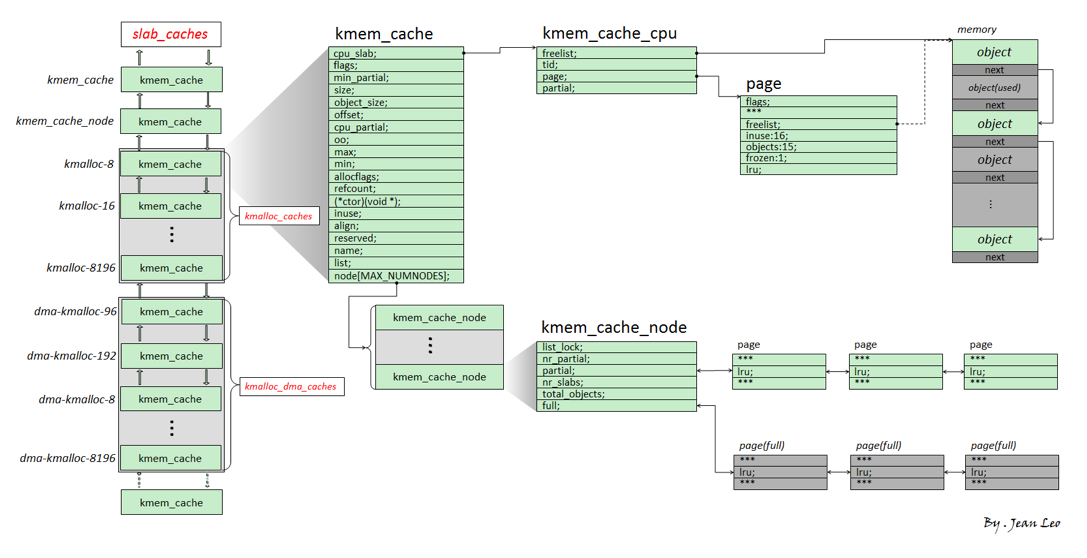因为课程作业里接触到了uaf的kernel pwn,虽然比较基础,但是还是有那么点基础,理解起来不会很吃力。这次复现的是CISCN 2017的一个kernel pwn babydriver,比较简单的UAF,但是还是有一些细节知识值得学习。
相关知识点
slub分配器
先贴张图:
简单地了解一下内核内存管理的一些简单的特点,至于更深入的代码细节可以参考”Kernel Pwn 学习之路”系列文章。
- 与glibc中的
malloc有点相同的是,kmalloc同样需要对齐到某些特定的大小,只不过这个范围更加特殊。通过sudo cat /proc/slabinfo | grep "^kmalloc"查看可以分配的object大小。因此当需要分配一块内存的时候,chunk的大小会向上对齐到满足需求的最小的那个object size。1
2
3
4
5
6
7
8
9
10
11
12
13kmalloc-8192 479 500 8192 4 8 : tunables 0 0 0 : slabdata 125 125 0
kmalloc-4096 1356 1384 4096 8 8 : tunables 0 0 0 : slabdata 173 173 0
kmalloc-2048 2322 2368 2048 16 8 : tunables 0 0 0 : slabdata 148 148 0
kmalloc-1024 6702 6720 1024 32 8 : tunables 0 0 0 : slabdata 210 210 0
kmalloc-512 30090 30464 512 64 8 : tunables 0 0 0 : slabdata 476 476 0
kmalloc-256 187245 187328 256 64 4 : tunables 0 0 0 : slabdata 2927 2927 0
kmalloc-192 5858 6174 192 42 2 : tunables 0 0 0 : slabdata 147 147 0
kmalloc-128 3304 3904 128 64 2 : tunables 0 0 0 : slabdata 61 61 0
kmalloc-96 193746 193746 96 42 1 : tunables 0 0 0 : slabdata 4613 4613 0
kmalloc-64 54702 85696 64 64 1 : tunables 0 0 0 : slabdata 1339 1339 0
kmalloc-32 14245 15744 32 128 1 : tunables 0 0 0 : slabdata 123 123 0
kmalloc-16 15616 15616 16 256 1 : tunables 0 0 0 : slabdata 61 61 0
kmalloc-8 16384 16384 8 512 1 : tunables 0 0 0 : slabdata 32 32 0 - 一般来说,
kmalloc分配出来的chunk在物理地址上都是连续的,(有时会出现第一个chunk不连续的情况)。也就是说slub分配器中维护的freelist,存放一个单向链表,这个链表将该slub中空闲的object串起来,通过设置object首8 bytes(x86为4 bytes)为下一个object的指针来实现。当有chunk被kfree掉时,会相应的放在对应size的freelist头部。至于关于object的其他的各种metadata,都会维护在相应的结构体中,这里不进行深入分析。 - 同glibc的
malloc类似,kmalloc也不会清空chunk中的原有数据。
cred结构体
linux-4.4.72的cred结构体的定义如下(其中atomic_t,kuid_t,kgid_t都是4 bytes的数据类型):
1 | struct cred { |
cred结构体的作用是储存某个进程的相关信息,标志它的权限,故如果修改了进程对应的cred结构体,也就修改了这个进程的权限。
因此只要将进程的uid和gid改为0,就能达到提权的目的。
此外由于cred结构体在不同版本的kernel里,大小可能不尽相同,如果直接看源码计算它的大小可能不太方便,因此可以通过:
- 修改文件系统镜像
rootfs.cpio解包出的init,将setgiduid的命令,例如:修改为root用户:1
setsid cttyhack setuidgid 1000 sh
这样内核启动完,就能以root的身份登录。1
setsid cttyhack setuidgid 0 sh
- 编写获取
cred结构体大小的简单模块,打包进文件系统镜像中,如:这样在目标系统启动后,插入模块就能获得1
2
3
4
5
6
7
8
9
10
11
12
13
14
15
16
17
18
19
20
21
22
23// Use for get struct cred size
struct cred c;
static int get_cred_size_init(void)
{
printk(KERN_INFO "[!] Start!\n");
printk(KERN_INFO "[+] Size of cred struct: %lx\n", sizeof(c));
return 0;
}
static void get_cred_size_exit(void)
{
printk(KERN_INFO "[!] Exit!\n");
}
module_init(get_cred_size_init);
module_exit(get_cred_size_exit);
MODULE_LICENSE("GPL");cred结构体的大小。
fork
对于一个进程fork出来的子进程,由于最开始子进程会和父进程共享内存空间,只有内存中的信息要发生变化的时候,才会分配出相应的内存。因此如果父进程释放一个与cred结构体大小相同的chunk,子进程在创建自己的cred结构体的时候,会从释放的chunk中拿到内存空间,这就促使了uaf的利用。
ciscn 2017 babydriver复现
题目分析
查看保护机制:
1 | Arch: amd64-64-little |
同时从boot.sh中,查看qemu的参数,开启了smep:
1 | -cpu kvm64,+smep |
ioctl只提供了一个kmalloc的功能,为全局变量babydev_struct结构体的成员变量device_buf分配空间(事先会调用kfree先释放空间),其中size可控:
1 | // local variable allocation has failed, the output may be wrong! |
close的回调函数babyrelease通过kfree释放了babydev_struct->device_buf的空间:
1 | int __fastcall babyrelease(inode *inode, file *filp) |
read的回调函数babyread读取babydev_struct->device_buf的内容:
1 | ssize_t __fastcall babyread(file *filp, char *buffer, size_t length, loff_t *offset) |
write的回调函数babywrite向babydev_struct->device_buf写入数据,size可控:
1 | ssize_t __fastcall babywrite(file *filp, const char *buffer, size_t length, loff_t *offset) |
利用思路
- 结构体
babydev_struct是全局变量,因此如果开启两个设备,第二个设备kmalloc出的babydev_struct->device_buf指针会会覆盖掉第一个设备的babydev_struct->device_buf(因为实际上是同一个)。因此如果close第二个设备,触发kfree操作释放掉babydev_struct->device_buf但是没有清空指针,就会造成uaf漏洞,因为此时第一个设备仍然可以操作babydev_struct->device_buf变量。 - 利用
ioctl控制babydev_struct->device_buf的size为0xA8(sizeof(struct cred)),使得close第二个设备的时候释放一个size=0xC0的chunk到slub中。 fork一个子进程,由于子进程创建的cred结构体会从上述释放的0xC0的chunk中获得,所以第一个设备的babydev_struct->device_buf和子进程的cred同时指向一个chunk。- 在子进程中调用第一个设备的
write,将子进程的cred结构体中的uid和gid改为0,完成提权。 - 在子进程开启shell,get root shell。
exp
1 |
|
小结
- 与glibc的uaf利用基本类似,只不过因为是kernel pwn,要具有多线程的思维,这点很重要,因为许多情况在单线程思维的角度中是不会发生的,但是多线程下却是可能的。
- 相比于调用
commit_creds(prepare_kernel_cred(0));的函数调用的提权方式,直接修改cred结构体提权显得简单粗暴。 - 这道babydriver的题似乎还有rop绕过smep的做法,后面浮现后,会补充在上篇ROP的文章里。